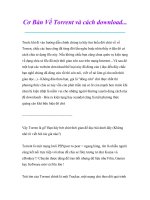THE MECHANICS OF SUBNETTING (MẠNG máy TÍNH cơ bản SLIDE)
Bạn đang xem bản rút gọn của tài liệu. Xem và tải ngay bản đầy đủ của tài liệu tại đây (734.63 KB, 35 trang )
Chương 10:
THE MECHANICS OF SUBNETTING
10.1. Classes of network IP addresses
• Classes of IP addresses offer a range from
254 to 16.8 million hosts, as discussed
previously in this module. To efficiently
manage a limited supply of IP addresses, all
classes can be subdivided into smaller
subnetworks.The
figure
provides
an
overview of the division between networks
and hosts
Computer Network
1
Computer Network
2
10.2. Introduction
subnettingtting
to
and
reason
for
• To create the subnetwork structure, host bits
must be reassigned as network bits. This is
often referred to as ‘borrowing’ bits. However,
a more accurate term would be ‘lending’ bits.
The starting point for this process is always
the leftmost host bit, the one closest to the
last network octet.
Computer Network
3
• Subnet addresses include the Class A, Class
B, and Class C network portion, plus a subnet
field and a host field. The subnet field and the
host field are created from the original host
portion of the major IP address. This is done
by assigning bits from the host portion to the
original network portion of the address. The
ability to divide the original host portion of
the address into the new subnet and host
fields provides addressing flexibility for the
network administrator.
Computer Network
4
Computer Network
5
Computer Network
6
Computer Network
7
• In addition to the need for manageability,
subnetting enables the network administrator to
provide broadcast containment and low-level
security on the LAN.
• Subnetting provides some security since
access to other subnets is only available
through the services of a router. Further, access
security may be provided through the use of
access lists. These lists can permit or deny
access to a subnet, based on a variety of
criteria, thereby providing more security.
Access lists will be studied later in the
curriculum. Some owners of Class A and B
networks have also discovered that subnetting
creates a revenue source for the organization
through the leasing or sale of previously
unused IP addresses.
Computer Network
8
• A LAN is seen as a single network with no
knowledge of the internal network structure.
This view of the network keeps the routing
tables small and efficient. Given a local node
address of 192.168.10.14, the world outside
the LAN sees only the advertised major
network number of 192.168.10.0. The reason
for this is that the local address of
192.168.10.14 is only valid within the LAN
192.168.10.0 and cannot function anywhere
else.
Computer Network
9
10.3. Establishing the subnet mask address
• Selecting the number of bits to use in the
subnet process will depend on the maximum
number of hosts required per subnet. An
understanding of basic binary math and the
position value of the bits in each octet is
necessary when calculating the number of
subnetworks and hosts created when bits
were borrowed.
Computer Network
10
Computer Network
11
• The last two bits in the last octet, regardless of
the IP address class, may never be assigned
to the subnetwork. These bits are referred to
as the last two significant bits. Use of all the
available bits to create subnets, except these
last two, will result in subnets with only two
usable hosts. This is a practical address
conservation method for addressing serial
router links. However, for a working LAN this
would result in prohibitive equipment costs.
• The subnet mask gives the router the
information required to determine in which
network and subnet a particular host resides.
Computer Network
12
Computer Network
13
• The subnet mask is created by using binary
ones in the host octet or octets. The subnet
octet or octets are determined by adding the
position value of the bits that were borrowed.
If three bits were borrowed, the mask for a
Class C address would be 255.255.255.224.
Computer Network
14
Computer Network
15
• This mask may also be represented, in the
slash format, as /27. The number following
the slash is the total number of bits that were
used for the network and subnetwork portion.
• To determine the number of bits to be used,
the network designer needs to calculate how
many hosts the largest subnetwork requires
and the number of subnetworks needed. As
an example, the network requires 30 hosts
and five subnetworks. A shortcut to
determine how many bits to reassign is by
using the subnetting chart.
Computer Network
16
Computer Network
17
• The method that was used to create the
subnet chart can be used to solve all
subnetting problems. This method uses the
following formula:
Computer Network
18
• Number of usable subnets= two to the
power of the assigned subnet bits or
borrowed bits, minus two (reserved
addresses
for
subnetwork
id
and
subnetwork broadcast)
(2 power of borrowed bits)–2=usable subnets
Example: (23)–2=6
Computer Network
19
• Number of usable hosts= two to the power of
the bits remaining, minus two (reserved
addresses for subnet id and subnet
broadcast)
(2 power of remaining host bits) – 2=usable hosts
Example (25)–2=30
Computer Network
20
10.4. Applying the subnet mask
• Once the subnet mask has been established it then
can be used to create the subnet scheme.
Computer Network
21
• The chart in the Figure is an example of the
subnets and addresses created by assigning
three bits to the subnet field. This will create
eight subnets with 32 hosts per subnet. Start
with zero (0) when numbering subnets. The
first subnet is always referenced as the zero
subnet.
Computer Network
22
• When filling in the subnet chart three of the
fields are automatic, others require some
calculation. The subnetwork ID of subnet zero
is the same as the major network number, in
this case 192.168.10.0. The broadcast ID for
the whole network is the largest number
possible, in this case 192.168.10.255. The
third number that is given is the subnetwork
ID for subnet number seven. This number is
the three network octets with the subnet mask
number inserted in the fourth octet position.
Three bits were assigned to the subnet field
with a cumulative value of 224.
Computer Network
23
Computer Network
24
• The ID for subnet seven is 192.168.10.224. By
inserting these numbers, checkpoints have
been established that will verify the accuracy
when the chart is completed.
• When consulting the subnetting chart or
using the formula, the three bits assigned to
the subnet field will result in 32 total hosts
assigned to each subnet. This information
provides the step count for each subnetwork
ID. Adding 32 to each preceding number,
starting with subnet zero, the ID for each
subnet is established. Notice that the subnet
ID has all binary 0s in the host portion.
Computer Network
25









